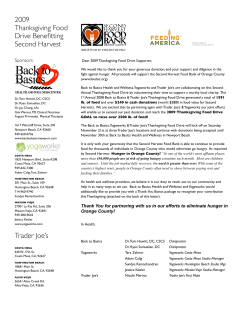
Antennas 101 The Basics Ward Silver NØAX
Antennas 101 The Basics Ward Silver NØAX The Basics - 1 • Antennas radiate (or receive) because electrons are accelerated (or are caused to accelerate) in the antenna’s elements • Radio or electromagnetic waves are both an E- (electric) and H- (magnetic) field • Electrons move parallel to E-fields • Strongest radiation from accelerating electrons linearly (back and forth) 2013 Antennas 101 2 The Basics - 2 • The orientation of the E-field determines the polarization of the wave because that’s what makes the electrons move (current) • Antennas transmit & receive radio waves in the same way • The radiation pattern shows how antennas distribute energy in space 2013 Antennas 101 3 The Basics - 3 • deciBels (dB) = 10 log (power ratio) • Impedance = ratio of Voltage to Current • Feed point - place where power is applied 2013 Antennas 101 4 The Basics - 4 -1 dB from the maximum gain reference value Azimuthal Pattern 2013 Antennas 101 5 The Basics - 5 Elevation Pattern 2013 Antennas 101 6 The Basics - 6 • Front-to-Back, Front-to-Side, and Frontto-Rear ratios – Front-to-Rear ratio based on an average across 90 or 180 degrees “behind” the antenna in the pattern’s rear quadrant(s) 2013 Antennas 101 7 The Basics - 6 Rear Front Back Side 2013 Antennas 101 8 The Basics - 6 • Beamwidth - angular width of main lobe – Angle between the two points at which power is ½ that at the peak (-3 dB points) 2013 Antennas 101 9 The Basics - 6 - 3 dB Beamwidth 68° 2013 Antennas 101 10 The Basics - 7 • Gain measures re-distribution of energy • Gain is a comparison of antennas • Gain is always with respect to a reference – – – – 2013 dBi (isotropic), dBd (free-space /2 dipole) /2 dipole has 2.15 dBi gain Ground-plane gain equivalent to /2 dipole 3-element Yagi may have up to 5 dBd gain Antennas 101 11 QUESTIONS?? 2013 Antennas 101 12 The Dipole - 1 • Oldest and simplest form of antenna – “Di” (two) “Pole” (voltage polarity) – Usually 1/2-wavelength long • Similar to a vibrating string’s fundamental – Current maximum in the middle – Voltage maximum at the ends • Pattern repeats every 1/2-wavelength – Direction or amplitude is reversed 2013 Antennas 101 13 The Dipole - 2 Current maximum (I) feed point Voltage minimum (V) 1/2 wavelength IMPORTANT!!! A /2 2013 B /2 Antennas 101 V I C /2 14 The Dipole - 3 • Free-space wavelength () – = c / f or 300 / f in MHz (in meters) – /2 = 492 / f in MHz (in feet) • Length-to-diameter effect – Makes the antenna a little longer electrically – Thicker conductors are longer electrically • Effect of height on electrical length – 460/f to 490/f (rarely 468/f) 2013 Antennas 101 15 The Dipole - 4 • Radiated energy is strongest perpendicular to an electron’s motion – electrons move along the length of a dipole – radiation strongest broadside to the dipole 2013 Antennas 101 16 The Dipole - 4 Directions of Maximum Radiation Directions of Minimum Radiation Dipole Axis Radiation Pattern 2013 Antennas 101 17 The Dipole - 5 • Feed point impedance varies with position – High at the ends and low in the middle – Resonance – feed point impedance all resistive, no reactance • Z = R + j 0 ohms • Doesn’t matter what R is (any value, not just 50 Ω) 2013 Antennas 101 18 The Dipole - 5 Current Maximum (I) feed point Voltage Minimum (V) 1/2 wavelength High Z Low Z H A /2 2013 L B /2 Antennas 101 H V L I H C /2 19 The Dipole - 6 • Inverted-Vee is a “bent” dipole • Radiation pattern adds the effect of ground gain from reflections – Can add as much as 6 dB over free space – Free-space gain best comparative measure • Ground gain varies with height and with ground conductivity 2013 Antennas 101 20 The Dipole - 6 35° /2 ground Inverted-Vee Radiation Pattern 2013 /2 Antennas 101 21 QUESTIONS?? 2013 Antennas 101 22 The Ground Plane - 1 • Start with a vertical dipole in free-space • Cut off one half of the dipole • Replace the missing half with a ground plane or counterpoise • Omnidirectional if oriented vertically • Also called a monopole 2013 Antennas 101 23 The Ground Plane - 2 2013 Antennas 101 24 The Ground Plane - 3 2013 Antennas 101 25 The Ground Plane - 4 • Equal radiation broadside • Nulls along the axis 2013 Antennas 101 26 The Ground Plane - 5 • Length (ft) 234 / f (MHz) – 231 / f if #14 wire used, - 221 if 5/8” tubing • Feed point impedance 35 Ω – if radials used, sloping increases feed point impedance – approximately 45° of droop gives best match – halfway between dipole (72 Ω) and ground plane (35 Ω) 2013 Antennas 101 27 Useful References and Books • ARRL Publications – Antenna Book, Basic Antennas – Compendium and Classics series • RSGB Publications – Practical Wire Antennas and HF Antennas for all Locations • CQ Communications – Sevick’s and Maxwell’s books on xmsn lines, baluns – Vertical Handbook, All About Quads 2013 Antennas 101 28 Useful On-Line References • ARRL Technical Information Service • AC6V.com and Dxzone.com • L.B. Cebik’s web site - www.cebik.com – Part of the Antennex.com site (subscription) • Antennas and TowerTalk reflectors at www.contesting.com 2013 Antennas 101 29 Thank You! 2013 Antennas 101 30
© Copyright 2025





















